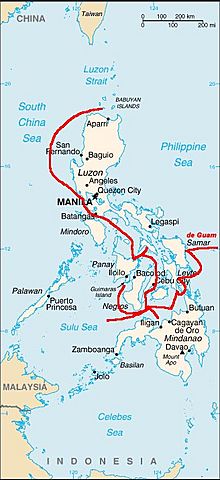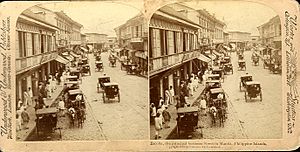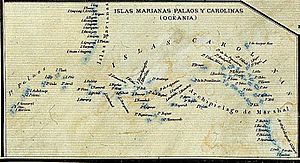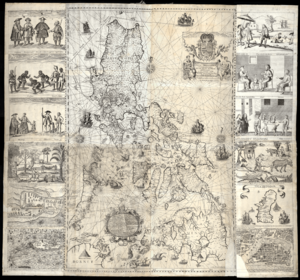Spanish East Indies facts for kids
Quick facts for kids
Spanish East Indies
Indias orientales españolas
|
|||||||||||||||||||||||||||||||||||||||||||||||
|---|---|---|---|---|---|---|---|---|---|---|---|---|---|---|---|---|---|---|---|---|---|---|---|---|---|---|---|---|---|---|---|---|---|---|---|---|---|---|---|---|---|---|---|---|---|---|---|
| 1565–1898 | |||||||||||||||||||||||||||||||||||||||||||||||
|
Motto: Plus Ultra
"Further Beyond" |
|||||||||||||||||||||||||||||||||||||||||||||||
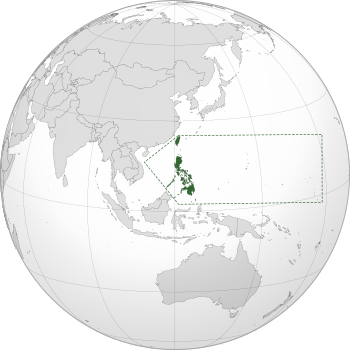
Spanish East Indies
|
|||||||||||||||||||||||||||||||||||||||||||||||
| Status | Territories of Spain (Territory of New Spain from 1565 to 1821, and province of Spain from 1821 to 1898) |
||||||||||||||||||||||||||||||||||||||||||||||
| Capital | |||||||||||||||||||||||||||||||||||||||||||||||
| Common languages | Spanish (official) Philippine languages, Micronesian languages, Kavalanic East Formosan languages, Hokkien |
||||||||||||||||||||||||||||||||||||||||||||||
| Religion | Roman Catholicism (state religion), Islam, Philippine traditional religion, Micronesian traditional religion, Taiwanese aboriginal traditional religion, Overseas Chinese folk religion |
||||||||||||||||||||||||||||||||||||||||||||||
| Monarch | |||||||||||||||||||||||||||||||||||||||||||||||
|
• 1565–1598 (first)
|
Philip II | ||||||||||||||||||||||||||||||||||||||||||||||
|
• 1886–1898 (last)
|
Alfonso XIII | ||||||||||||||||||||||||||||||||||||||||||||||
| Governor-General | |||||||||||||||||||||||||||||||||||||||||||||||
|
• 1565–1572 (first)
|
Miguel López de Legazpi | ||||||||||||||||||||||||||||||||||||||||||||||
|
• 1898 (last)
|
Diego de los Ríos | ||||||||||||||||||||||||||||||||||||||||||||||
| Legislature | Cortes Generales | ||||||||||||||||||||||||||||||||||||||||||||||
| Historical era | Spanish Empire | ||||||||||||||||||||||||||||||||||||||||||||||
|
• Colonization
|
27 April 1565 | ||||||||||||||||||||||||||||||||||||||||||||||
|
• East Indies colony established
|
28 September 1821 | ||||||||||||||||||||||||||||||||||||||||||||||
|
• Philippine declaration of independence
|
12 June 1898 | ||||||||||||||||||||||||||||||||||||||||||||||
| 10 December 1898 | |||||||||||||||||||||||||||||||||||||||||||||||
| 12 February 1899 1898 | |||||||||||||||||||||||||||||||||||||||||||||||
| 23 March 1901 | |||||||||||||||||||||||||||||||||||||||||||||||
| Area | |||||||||||||||||||||||||||||||||||||||||||||||
| 1877 | 345,155 km2 (133,265 sq mi) | ||||||||||||||||||||||||||||||||||||||||||||||
| Population | |||||||||||||||||||||||||||||||||||||||||||||||
|
• 1877
|
5,567,685 | ||||||||||||||||||||||||||||||||||||||||||||||
| Currency | Spanish dollar, Spanish peseta | ||||||||||||||||||||||||||||||||||||||||||||||
|
|||||||||||||||||||||||||||||||||||||||||||||||
The Spanish East Indies were lands in Asia and Oceania that belonged to the Spanish Empire. These territories were ruled by the Spanish Crown from 1565 to 1898. They were governed from Mexico City and later from Madrid, with Manila as the main center.
The King of Spain used to call himself "King of the East and West Indies." From 1565 to 1821, these lands were managed through the Viceroyalty of New Spain in Mexico City. After Mexico became independent, the Spanish East Indies were ruled directly from Madrid.
These territories included what is now the Philippines, Guam, and the Mariana Islands. They also included Palau, parts of Micronesia, and for a short time, Northern Taiwan, and parts of North Sulawesi and the Moluccas. The first capital was Cebu, but it later moved to Manila.
In 1898, after the Spanish–American War, the United States took control of the Spanish Philippines and Guam. Spain then sold other smaller islands to Germany in 1899. The few remaining islands were given to the United States in 1901.
Contents
History of Spanish East Indies
Early Explorations and Settlements (1521–1643)
The Portuguese controlled the sea routes around Africa to the Indian Ocean. So, Spain needed to find a different way to reach the Far East. The Magellan–Elcano expedition, which sailed from 1519 to 1522, found a route around South America into the Pacific Ocean.
This expedition reached the Mariana Islands on March 6, 1521. They then arrived in the Philippines. There, Magellan made friends with Rajah Humabon, the leader of Cebu, and helped him convert to Catholicism. However, Magellan died soon after in the Battle of Mactan.
After Magellan's death, the expedition faced trouble. The survivors reached the Sultanate of Tidore in the Spice Islands in November 1521. The sultan of Tidore, Al-Mansur of Tidore, became a Spanish ally. He hoped Spain would help him against his rival, the Sultan of Ternate, who was supported by the Portuguese.
However, the Portuguese forced Al-Mansur to end his alliance with Spain. One of Magellan's ships, the Victoria, managed to return to Spain in September 1522, completing the first trip around the world. Spain later gave up its claims in the East Indies for money in 1529.
Establishing Spanish Rule in the Philippines
Spain wanted to create trade routes between the East Indies and the Americas across the Pacific. Antonio de Mendoza sent Ruy López de Villalobos to the Philippines in 1542. Later, Miguel López de Legazpi sailed from Mexico and set up the first Spanish settlement in the Philippines in 1565. This settlement became the town of San Miguel in Cebu.
In the same year, Andrés de Urdaneta, another member of the expedition, found a sea route from the Philippines back to Mexico. This discovery led to the important Manila-Acapulco Galleons trade route across the Pacific.
In 1571, the Spanish took control of Maynila, a city-state. They renamed it Manila and made it the capital of the Captaincy General of the Philippines. Some local kingdoms, like the Rajahnate of Butuan and the Kedatuans of Dapitan and Madja-as, joined the Spanish. They allied against their Muslim rivals. The Spanish also took Zamboanga from the Sultanate of Sulu. All these areas became part of the Spanish East Indies.
The Philippines became a base for Spanish actions in Asia. This included wars against the Sultanate of Brunei and campaigns in Cambodia and Taiwan. These territories were managed by the Viceroyalty of New Spain in Mexico City.
The Manila-Acapulco galleons carried goods like silk, spices, silver, and gold from Asia and the Pacific to Mexico. From Mexico, these goods were sent to Spain and then to Europe. Spanish and Mexican sailors also brought their customs, religion, languages, and foods to the Philippines, Guam, and the Mariana Islands.
Later Explorations and Conflicts
In 1606, the Spanish started trading with the Maluku Islands, continuing until 1663. They also had contact with Japan until Japan closed its trading posts in 1630. In northeastern Taiwan, the Spanish built Fort Santo Domingo in 1626 and a mission in Tamsui in 1628. They held these until they lost them in 1642.
Spanish ships visited several Pacific islands in the 1500s, including New Guinea (1545), the Solomon Islands (1568), and the Marquesas Islands (1595). However, they did not try to trade with or colonize these islands.
In 1668, Diego Luis de San Vitores started the first mission on Guam. He and Pedro Calungsod later died there.
In 1762, British troops briefly captured Manila and other areas during the Seven Years' War. The Spanish and local forces tried to resist. There were also local rebellions led by people like Diego Silang and his wife Gabriela, who supported the British. Manila was returned to Spain in 1764 as part of a peace agreement.
How the Colonies Were Governed
The Seven Years' War led King Charles III to make big changes to how his overseas lands were governed. In 1784, a new office called an intendencia was set up in Manila. Its job was to manage government money and help the economy grow. Governor-General José Basco y Vargas also created the Economic Society of the Friends of the Country to encourage new ideas and education.
For over 256 years, the Spanish East Indies were ruled by a governor-captain general and a high court called an audiencia. The Viceroyalty of New Spain in Mexico managed all economic matters for the Philippines. Most government messages went through Mexico, not directly to Spain. This was because the eastward sea route was often used for military purposes and trade, like the Manila-Acapulco galleon trade.
In 1821, the Viceroyalty of New Spain ended after the Mexican War of Independence. All control of the Spanish East Indies then moved to Madrid. This continued until the United States took most Spanish territories in Asia-Pacific after the Spanish–American War in 1898.
The Audiencia and Captaincy General
In 1574, the Captaincy General of the Philippines was created. It was a part of the Viceroyalty of New Spain. The Real Audiencia of Manila, a high court, was set up on May 5, 1583. Its first meeting was on June 15, 1584. The Governor-General of the Philippines was its highest judge. Both of these important groups were created by King Felipe II.
The laws from 1680 described what the Audiencia and its president could do. It said that the Audiencia would be in the city of Manila on Luzon Island. It would have a president, who was also the governor and captain general. There would be four judges for civil and criminal cases, a crown attorney, and other officials.
The Audiencia's area included Luzon Island, the rest of the Philippines, the China Archipelago, and other lands discovered or to be discovered. The governor and captain general had full control over the government, both in war and peace. He would make decisions and grant favors in the King's name. For important matters, the president-governor would ask the judges for their advice. After hearing their opinions, he would make the best decision for God, the King, and the peace of the province.
Lands Under Spanish Rule
The Spanish East Indies included:
- The Captaincy General of the Philippines (1565–1898), which is now the Philippines. This included Manila, Luzon, the Visayas, Palawan, and parts of Mindanao. It also had small outposts in Keelung, Taiwan, and in the islands of Gilolo, Ternate, Tidore, and Manado in Indonesia.
- The Islas Carolinas (now the Federated States of Micronesia) (1686–1899).
- The Islas Marianas (now the Commonwealth of the Northern Mariana Islands and Guam) (1667–1898 or 1899).
- The Islas Palaos (now the Republic of Palau) (1574–1899).
- The Marshall Islands (1874–1885).
- Parts of Formosa (now Taiwan) (1626–1642).
- Parts of Sulawesi and the Moluccas (Maluku Islands) (1580–1663), which are now part of Indonesia.
The Spanish also used different names for some areas. They called Mindanao "Gran Moluca" (Great Moluccas) and Luzon "Nueva Castilla" (New Castile).
Spain was mostly interested in using the region as a base for trade with East Asia. So, direct Spanish control grew slowly. The Batanes Islands were taken over in the 1700s. The highlands of Luzon were not fully controlled until the early 1800s. The very southern tip of Palawan was not controlled until the late 1890s.
Most of Mindanao was only partly under Spanish control. Groups like the Sulu Sultanate and the Sultanate of Maguindanao recognized Spanish rule but managed their own affairs. Many other local tribes also remained independent. Similarly, Palau and most of the Caroline Islands were not fully governed by Spanish missions until the early 1800s.
Cultural Influence in Former Spanish East Indies
Spanish Influence
Spain's impact on its former territories in Asia-Pacific is still very strong today. Most people in the Philippines, Guam, and the Mariana Islands are Roman Catholic. Spanish missionaries brought this religion in the 1500s and 1600s.
Many people in these countries were given Spanish names and surnames, which are still used. Spanish and Mexican people also brought new tools, products, crops, and technology. Because of this, many Spanish words are now part of the local languages. Art forms like music, architecture, and fashion also show a lot of Spanish influence. The food in these countries also has some Mexican and Spanish elements.
Filipino Influence
A large number of people in the Northern Mariana Islands (45–55%) and Guam (30–45%) are of Filipino descent. Also, 15–25% of the people in Palau are Filipino. Some local people in these areas use Filipino names and surnames. For example, the surname Pangelinan comes from the Filipino surname Pangilinan.
The current Chamorro population is thought to have some Filipino ancestry. This is because of the historical connections between Guam, the Northern Mariana Islands, and the Philippines during Spanish rule. It is also due to different waves of migration over time. The food in Guam, the Northern Mariana Islands, and Palau is also greatly influenced by Filipino cuisine. You can see this in dishes like Pancit, Lumpia, Kelaguen, Halo-halo, and Okoy.
See also
 In Spanish: Imperio español en Asia y Oceanía para niños
In Spanish: Imperio español en Asia y Oceanía para niños
- Spanish Filipino
- Dutch East Indies
- Captaincy General of the Philippines




